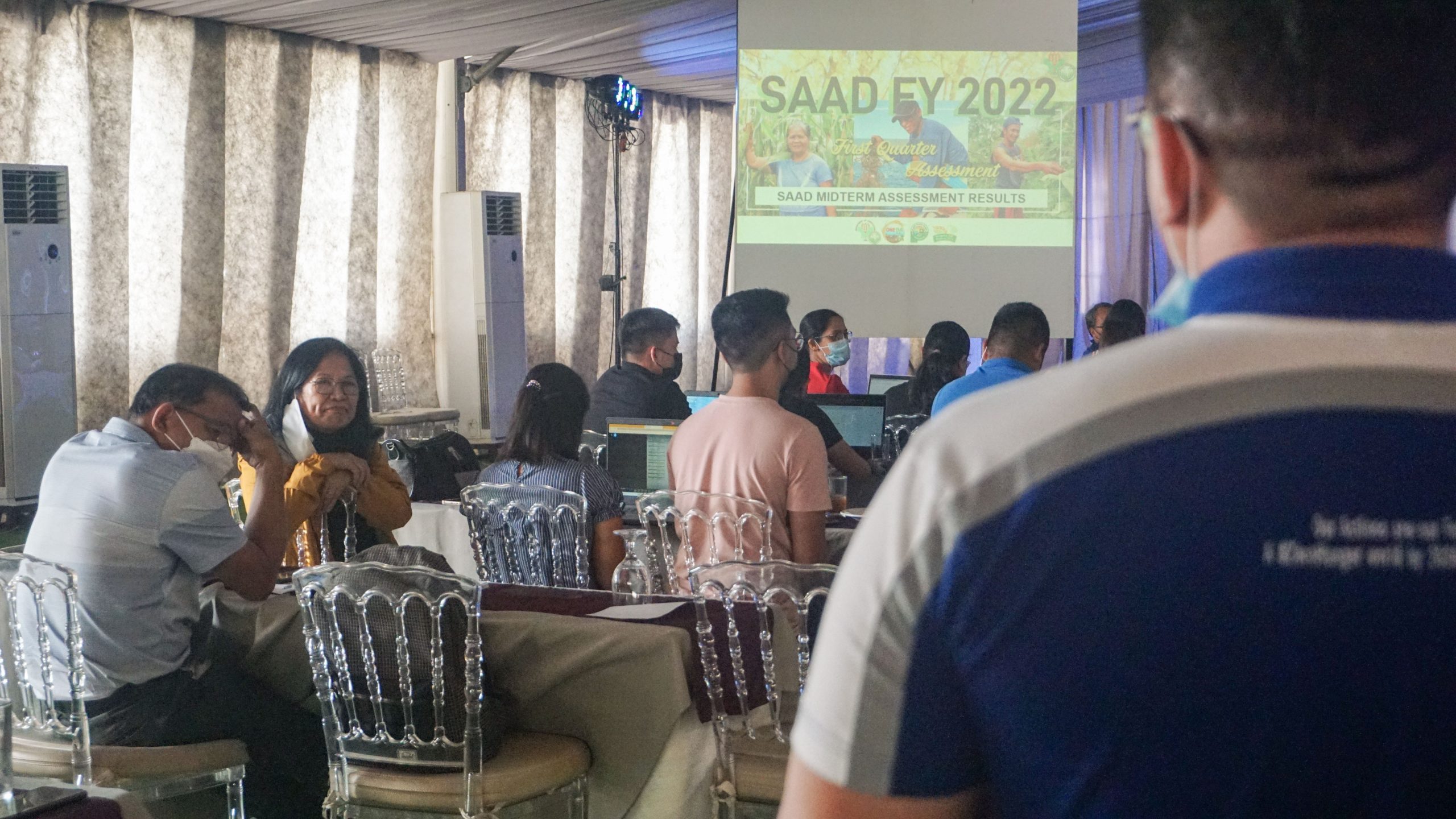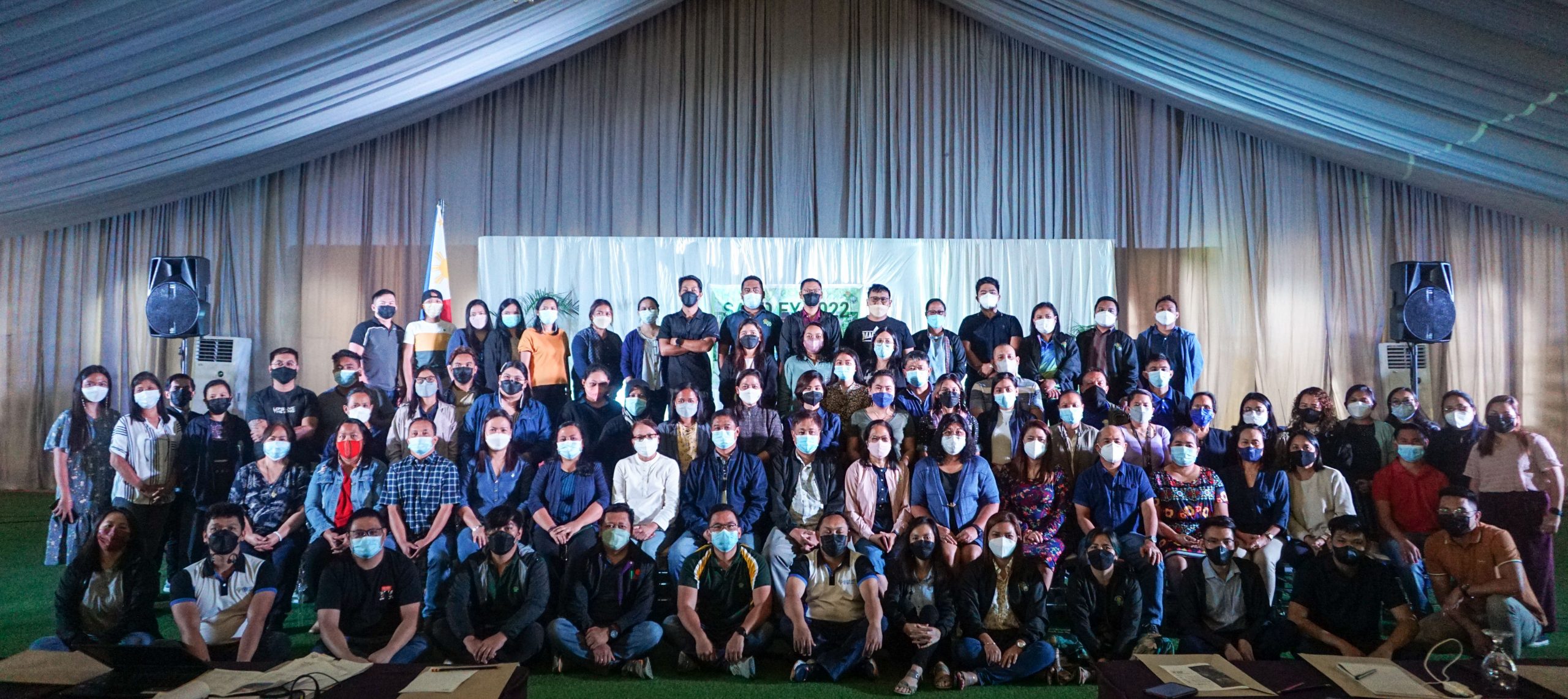
Remaining proactive while waiting for its proposed extension, the SAAD Program convened for the first time in the new normal setting to report on the progress of the program operations nationwide as its First Quarter Physical and Financial Assessment was held last April 25-29, 2022.
Attended by 110 participants, the SAAD National Program Management Office (NPMO) and the Regional Program Management Support Offices (RPMSOs) presented the status of their project implementation and the progress of accountabilities for each region and province. Non-SAAD regions namely, Ilocos Region (Region I), Cagayan Valley (Region II), Central Luzon (Region III), and CALABARZON (Region IV-A) were also invited to be acquainted with the operations.
Members of the SAAD Program Steering Committee (PSC) from the Agricultural Training Institute (ATI), Bureaus of Plant Industry (BPI), and Bureau of Animal Industry (BAI), also participated to polish and provide guidance on the issues raised by the regional implementers.
Issues and concerns
- Committed to its purpose as a developmental program dedicated to the marginalized communities, affected SAAD regions reported utilizing its continuing funds for relief assistance to the farmers severely affected by Typhoon Odette last December 2021.
- BAI representative accommodated and offered recommendations on the issues of animal acquisition processes such as suppliers’ permits.
- Areas with armed conflict or with identified End Local Communist Armed Conflict (ELCAC) operations remained difficult to penetrate for the purpose of reinforced monitoring of the projects.
- Enhanced monitoring in achieving beneficiaries’ and communities’ preparedness to establish an enterprise that will sustain their projects and income in the long run.
- Projects were delayed due to the limitation of the anticipated nationwide elections.
- While recurring issues on profiling bred in the discussions for quite some time now, the regional arms and the Central Office, led by the Information and Technology (IT) Sub-unit are determined and agreed to settle the accountabilities as part of strengthening the unified database which contains the profile details of the beneficiaries. This profiling activity shall construct the baseline data upon which the delivery system of programs/projects will be strengthened.
Staying on track with the goal, as SAAD’s promise: Midterm program assessment
Agricultural development initiatives are imperative as these actions address rural development. Communities in the rural area are most often engaged in agriculture as their main livelihood, however, different policy structures, priorities, socio-cultural factors, and topographic qualities play different roles in the development or underdevelopment of the communities living in the rural areas. Hence, advancement in the agricultural disposition of communities is seen to translate to the strengthened material and social welfare of its members.
During the assessment meeting, SAAD Deputy Director Ulysses J. Lustria, Jr discussed the results and recommendations of the Midterm Impact Assessment conducted by the Don Mariano Marcos Memorial State University (DMMMSU). This assessment provided consolidated backing to the proposed extension of the program.
The SAAD Midterm Assessment study seeks to evaluate the effectiveness of the program’s four major components to identify the gaps in implementation and fill said gaps to achieve and maximize the potential impact of the projects on the beneficiaries. Dedicated to poverty alleviation and agricultural stakeholders’ empowerment, SAAD is a part of the redistribution mechanism with the aim to alleviate poverty incidence in the priority areas. This is made possible by filling these gaps with access to food production and economic capacity-building mechanisms.
Given its 5-year implementation, this study utilized a desktop analysis of the available materials/literature (secondary data) from the program and its partners. It also provided the basis for understanding the framework of the program upon which all operations are built upon. Data from this analysis was used to determine the samples and design for the survey.
An impact pathway was then mapped, which went through enhancement and validation while the study progresses that specifies how outcomes manifest from the conceptual framework of the program (mapping impacts from the 4 major components: [1] program management, [2] social preparation, [3] production and livelihood assistance, and [4] marketing assistance and enterprise) from which surveys and group discussions with the respondents were cultivated.
The study led by the DMMMSU commenced in January 2021 that targeted 20 provinces initially covered by SAAD during the 2017-2018 implementation. This was participated by 1,590 farmers and fisherfolk, and 57 associations.
This study is specifically geared towards exploring the impact of the program on poverty, food security, and agricultural productivity, as well as the projects’ adoption and non-adoption status (how likely the projects are continued or discontinued by the beneficiaries). It aims to explain and measure the impact felt by the farmer-beneficiaries.
Utilizing the Theory of Change as a lens to read the findings, the study ultimately aims to provide and define the purpose and the prevailing thinking that guide the implementation of the program. This is important as said theory, if well-articulated, can be a tool to establish a common understanding within the institution and reveal the needs for change, and a guide for collective thinking in addressing these needs, be it adaptive, iterative or linear and non-linear approaches to maximize the desired impacts.

Major findings
Overall, the SAAD program resulted in observed positive initial benefits for the targeted farmers and fisherfolks, particularly with respect to improving their household food consumption and other indicators of welfare gains and economic status.
The study revealed that 56.98% of the respondents agreed that their holistic welfare (considering financial status, housing characteristics, acquired assets, and education for children, either increased, improved, and/or attained) has improved with the presence of the SAAD projects. Likewise, 41.13% said they felt no change, while 1.89% claimed that their welfare deteriorated.
It is noteworthy however that the economy suffered from a backlash caused by the pandemic in 2020, and the country’s susceptibility to natural calamities every year, as a result of climate change. Another factor to be considered here is the amount of support (continued/one-time assistance) received by the farmers from SAAD.
Fundamentally, the program provides agricultural assistance, and livelihood projects to select farmers and fishers. This assessment revealed the beneficiaries’ reasons for adoption or non-adoption of the projects provided to them. Addressing food security, the highest rate is for home consumption as a reason to adopt the project that garnered the most response. Responding to agricultural productivity and poverty, lower production costs, increased income, increased harvest, and improved farming efficiency were among the top 5 reasons for project adoption. Meanwhile, inadequate interventions, low quality of seeds, the presence of pests, the pandemic, and the project-area misfit top the reasons for non-adoption of crops interventions. For livestock and poultry, the non-adoption emerges from mortality, inputs are not for a daily stream of income, production cost, and animal maintenance were top considerations.
Adoption trend is essential to understanding the pursuit of imparting positive changes in the quality of life of the farmers and fishers, as well as the sustainability of their projects turned to livelihood. The results may be used as a tool to craft better policies and implementation procedures, especially at the field level.
In addressing food security, following the impact pathway, the frequency of meals for farmers (at least three times a day) was recorded at 99.1% in 2016, went up to 99.8% in 2020, and increased from 94.7% to 97.4% for fisherfolk beneficiaries. Most importantly, farmers’ overall hunger incidence decreased from 7.8% to 5.0% from the 2016 to 2020 period after engaging in the program, while fisherfolk registered an average of 3.1% decrease per year from 14.1% in 2016 to 1.6% in 2020. Food variety consumed by both groups is also 94-98% after 4 years. Meanwhile, cases of malnutrition were relatively higher before the program began, with fluctuating records throughout the implementation; however, indicators of malnutrition include many factors that the program is not equipped to address such as the variety, quality, and quantity that could contribute to the nutritional requirement of the body.
In improving farmers’ income, the midterm report showed that from Php 10,600 average annual on-farm income, the farmer-beneficiaries generate around Php 18,400 under the 4-year program coverage, bringing about a 74% increase. Some agri-aqua farmers earned more than Php 72,000.00. For fishermen, the increase was from an average annual on-farm income of Php 26,340 to Php 48,940, an 86% increase. Some fishermen earned more than Php 100,000.
Increasing income means an increase in the budget for food that is reported to have 50-70% allocation per household. Included in the holistic welfare, the percentage of respondents who engage in debt agreements declined in the first three years of coverage; however, numbers increased in the fourth year while in the pandemic. This may connote financial difficulty; however, it is worth mentioning that debts are made for the purpose of investments and capital for succeeding production cycles.
The study further reveals an increase or improvement in terms of farmers’ and fishers’ savings, housing characteristics and other household logistics, and education of household members.
(Access the full assessment study at https://saad.da.gov.ph/saad-program-midterm-impact-assessment-report-2).
Further, the data gathered imply that the program has a real and felt impact on the welfare of the beneficiaries on the ground. It is imperative to mention that this success is not possible without the regional and provincial partners in implementation, as well as the cooperation of the local government units. Just as important as sharing these positive results, the points of improvement also call for a more intensive effort and collaboration between institutions to avoid hindrances.
While some of the recommendations in the study are perpetually aimed and conducted, as the program progresses, the most immediate response will be the grant for an extension, as well as the continued full support of the mother agency and its attached agencies for a more cohesive, science-based, transformative program especially for the marginalized, and vulnerable (physical or socio-cultural) communities.
This is a challenge to the incoming administration, to continue the legacy left by the previous leaders of the Department, from establishing a program that prioritizes the untouched and unheard communities, up to the science-based, community-led approach to bring forth systematic changes, and a transformation to a modernized and strong production for the farmers and fishers in the most marginalized areas in the country.
The program and its beneficiaries hope that the policy and lawmakers can see how from the original intent of just providing food on the table, the SAAD transforms the rural communities (women, indigenous people, youth, and seniors, all of whom are deprived of basic services) into independent food producers and agri-preneurs banking from the existing strength of their communities.
Moving Forward
Meanwhile, SAAD Program Director Dr. Myer G. Mula led the discussion on the directions of the program implementation in two different scenarios, considering the approval or disapproval of the proposed extension.
Regardless of the decision, whether the program will be granted another cycle to implement and expand, the whole SAAD team continues to enhance its operations and plans to properly usher the beneficiaries to the transition or conclusion of the program, which would mean the discontinuation of agricultural assistance targeted to the marginalized and isolated communities.
Writer: Jessamae Gabon, Information Officer, SAAD NPMO
Contributors:
Ulysses J. Lustria Jr.
Ian Kevin Sevilla
References:
Adekunle, A. A., & Fatunbi, A. O. (2014). A new theory of change in African agriculture. Middle-East
Journal of Scientific Research, 21(7), 10.5829/idosi.mejsr.2014.21.07.21564
Rodriguez, C. M., Bayani, K. G., Caccam, M. M., Prado, V. V., Nillo, R. G., Galiste, E. D., Baro, R. A.,
Domingo, MV. C., & Pajarillo, R. M. (2022). Midterm Impact Assessment Study of Special Area
for Agricultural Development (SAAD) Program. Don Mariano Marcos Memorial State University.
















Comments (0)